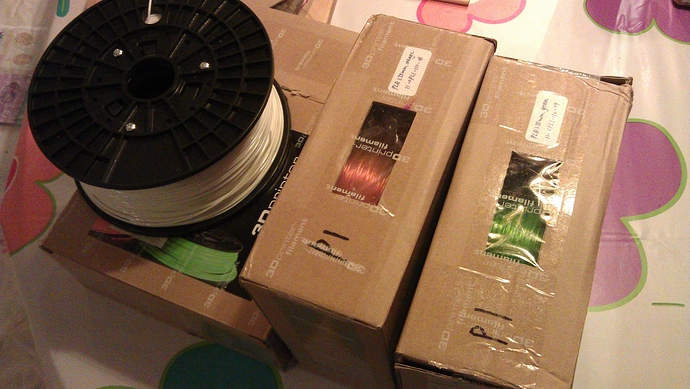Got my first order of filament. Will start testing tonight. It will be interesting to see what it is I’ve bought.
What type of filament (ABS/PLA, 1.75/3mm) and where’d you purchase from?
How is the accuracy of the diameter? That, and inclusions, seem to be the two big complaints about most Chinese filament.
I’m curious, in general, what the consequences of poor quality versus great quality filament are for printing?
As I understand it, there aren’t that many criteria for good-quality filament.
- Precision of diameter
- Purity of plastic
- Liquid/gas bubble content in plastic
What’s the danger of poor-quality filament to the actual prints? When testing filament from a new supplier, what are the red flags we should look out for?
The RepRap wiki articles were always pretty bare on these kinds of general information.
Poor precision on diameter will lead to over or under extrusion. The slicing software calculates how much filament to feed in based on a supplied diameter value. If the true value differs from this too much you’ll have problems. In extreme cases over-large filament may not fit into your hot end, causing a jam at that point.
Bubbles causes the same under extrusion problem because there’s a void in the plastic meaning the actual amount being fed through the hot end is lower than what the software expects.
Inclusions will cause jams at the nozzle. The hole in there is very small so even very small particulate may jam it.
Assuming you don’t jam and fail entirely, will the final strength of the plastic be affected by bad filament?
Will bad plastic adhere poorly? Will it bridge poorly? Will it break more easily at smaller resolutions?
That’s down to the actual composition of the plastic more than dimensional fidelity or purity. Although the underextrusion caused by filament that’s too small can result in a weaker print because the walls are thinner than intended.
Every batch of filament will be slightly different, from what I can tell, so every roll needs to be calibrated. But as long as the roll is consistent throughout then it should be fine after you’ve calibrated your settings.
I have measured the diameter and it ranges from 1.66-1.74. Dragging it between my fingers I can clearly feel the diameter change. No inclusions what I can see. I’ve printed some test objects and after changing the dimension stetting from 1.75 to 1.70 it looks ok. I haven’t played with any other settings yet. I’ve only printed 300g of faberdashery’s white filament before this so that is what I have to compare it to. The problems I see in the prints are the same as with the faberdashery so I guess I have some more calibration to to. Skeinforge has many options to try;)
